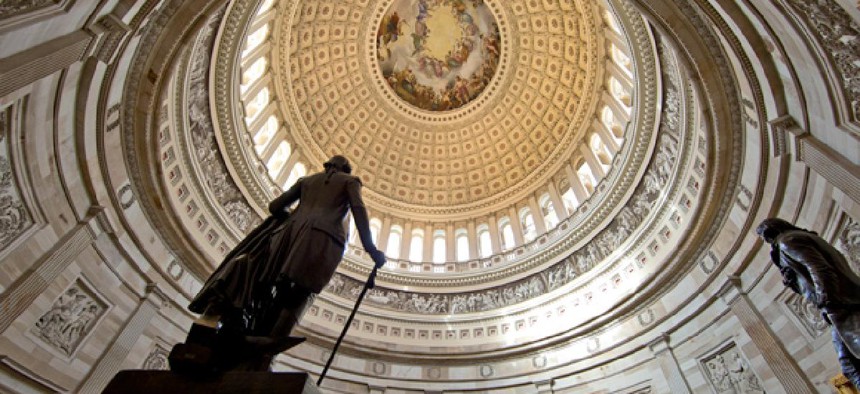
Alex Brandon/AP
Analysis: Sequestration Shows That Congress Needs to Be Fixed
Time to reform the institutional dysfunction that led us to crude budget cuts.
Almost a month into budget sequestration, the sky has not fallen, the sun comes out most days, and birds are still chirping.
Few would argue against the proposition that sequestration is a blunt, mindless instrument to cut budgets, treating all affected programs equally, largely ignoring Social Security, Medicaid, and Medicare, the biggest drivers in the rise in government spending. It causes pain and hardship and yet, it does seem to be working; it is bringing discretionary spending under control, even in a crude fashion. Call it a bad idea whose time has come.
But it raises the question of why things got to this point? Why was a budgetary nuclear weapon that was designed to be so awful that it would never be deployed, in fact, implemented?
Obviously, it was because the system failed to work. The political and policy process broke down, as the executive and legislative branches were unable to make decisions and cooperate enough to do what the Founding Fathers intended.
It has long been true in Washington that it is harder to stop something than to do something. The late House Speaker Sam Rayburn was fond of saying, “Any jackass can kick down a barn, but it takes a good carpenter to build one.” Today, even the best carpenters in this process are rendered ineffective and are outnumbered.
There are obviously many causes for what has gone horribly wrong with Washington over the last 40 years. Excessive partisanship — fueled by the increasingly negative rhetoric and advertising in politics and by certain cable-television shows that give a decidedly one-sided view of politics — is one contributing factor. These shows belie the famous line from the late Sen. Daniel Patrick Moynihan, D-N.Y., that everyone is entitled to their own opinions, but not their own set of facts. Now we have alternate ideological universes constructing their own versions of the facts, making compromise in the legislative process difficult. Those are just two of many triggers.
But institutionally in the House and the Senate, there are unique problems. In the House, the so-called “Hastert Rule” has become a perversion of the democratic and legislative process. By requiring a majority of the majority before moving a piece of legislation to the floor, it means that to pass, a bill either does little and offends few or is so ideologically skewed as to have little chance of passage in the Senate. My guess is that the conservatives who like the Hastert Rule so much would like it less if it was invoked by a Democratic speaker, thus allowing only very liberal legislation to move through the House. The concept of majority rule has been subverted.
In the Senate, between filibusters and the even more pernicious legislative “hold,” it is little wonder why House Speaker John Boehner, R-Ohio, has come to refer to the upper chamber as “a cemetery where legislation goes to die.”
Thorough debate and deliberation were the very ideas that made the idea of the U.S. Senate valuable and unique. Yet now, it has rendered the chamber largely impotent. A change in Senate rules in the 1970s allowed for “double-tracking” legislation: if one senator threatened a filibuster on a bill, that piece of legislation was set aside and other bills considered, reducing the pressure on that senator to end the faux filibuster.
The recent real filibuster by Sen. Rand Paul, R-Ky., the first in several years, was an example of how the filibuster process is supposed to work. One senator begins a filibuster, gets the publicity, and makes his or her point — then, if there are not others climbing on board, ends it out of exhaustion, hunger, or the need to go relieve one’s self.
But usually, just the use of this 10-letter “f-word” bottles things up. Filibusters rarely used to happen because they were arduous to conduct and created ill will with colleagues. Now, just the threat of one stops proposals and forces their proponents to seek to invoke cloture, tying up the Senate still further.
Holds were not widely used until the 1970s, when they were created in order for a senator to return to Washington or the floor before a piece of legislation of particular importance to that lawmaker would be considered. Before the 1970s, holds were more a courtesy than a parliamentary tactic. Now the abuse of holds, secret ones or not, has thrown yet another monkey wrench into the process.
Thoughtful members of Congress should now consider the implications of their actions and contemplate reforms and change practices. Getting rid of the filibuster would change the nature and purpose of the Senate and should be avoided. But reforming the process, starting with getting rid of double-tracking and putting strict time limits on holds, would be a start. So would the current and future House leaderships ending the practice of the Hastert Rule.
This article appeared in the Tuesday, March 26, 2013 edition of National Journal Daily.
NEXT STORY: Rebuilding the GOP






